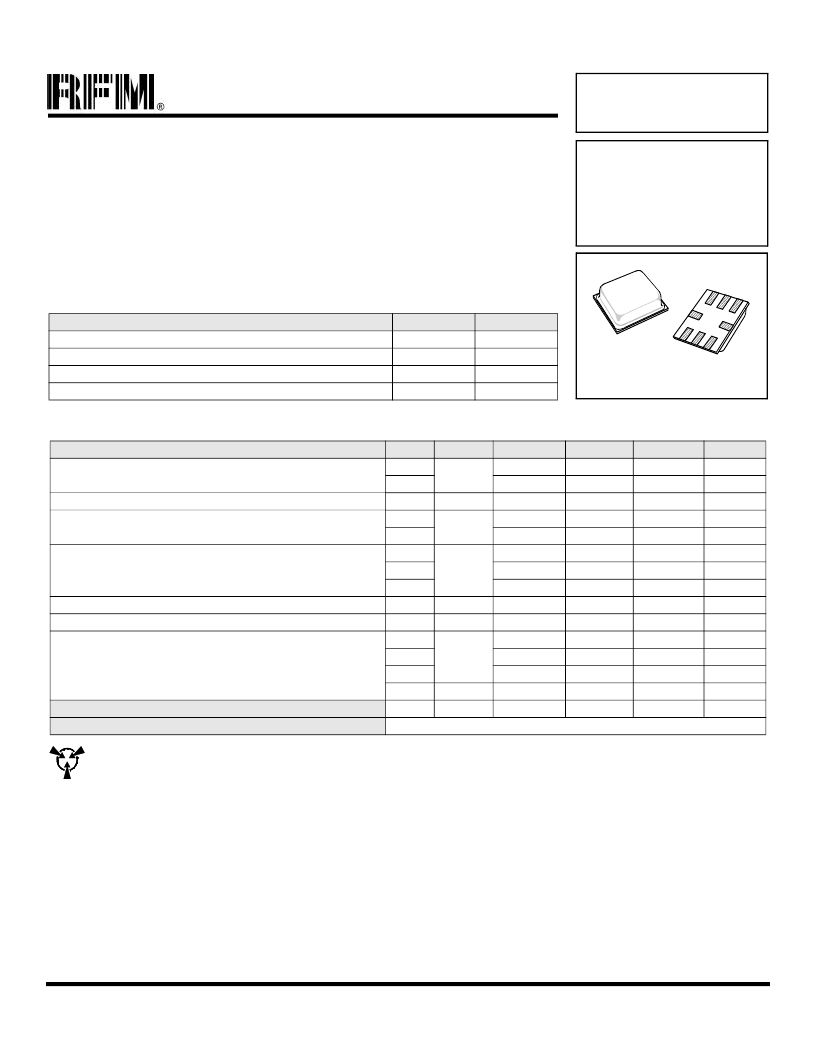- 您現(xiàn)在的位置:買賣IC網(wǎng) > PDF目錄373301 > RO2181B Analog IC PDF資料下載
參數(shù)資料
| 型號: | RO2181B |
| 英文描述: | Analog IC |
| 中文描述: | 模擬IC |
| 文件頁數(shù): | 1/2頁 |
| 文件大小: | 53K |
| 代理商: | RO2181B |

RF Monolithics, Inc.
RFM Europe
1999 by RF Monolithics, Inc. The stylized RFM logo are registered trademarks of RF Monolithics, Inc.
Phone: (972) 233-2903
Phone: 44 1963 251383
Fax: (972) 387-9148
Fax: 44 1963 251510
E-mail: info@rfm.com
http://www.rfm.com
RO2180B-031000
Page 1 of 2
Electrical Characteristics
Characteristic
Nominal Frequency
Tolerance from 433.92 MHz
Sym
f
C
Df
C
IL
Q
U
Q
L
T
O
f
O
FTC
|fA|
Notes
Minimum
433.845
Typical
433.92
Maximum
433.995
±75
Units
MHz
kHz
dB
Frequency (+25 °C)
2, 3, 4, 5
Insertion Loss
Quality Factor
2, 5, 6
2
Unloaded Q
50
Loaded Q
Turnover Temperature
Turnover Frequency
Frequency Temperature Coefficient
Absolute Value during the First Year
5, 6, 7
11,535
1,811
25
f
C+
16
0.032
≤
10
Temperature Stability
6, 7, 8
°C
ppm/°C
2
ppm/yr
M
μH
fF
pF
nH
Frequency Aging
DC Insulation Resistance between Any Two Terminals
RF Equivalent RLC Model
1
5
1.0
Motional Resistance
Motional Inductance
Motional Capacitance
Shunt Static Capacitance
R
M
L
M
C
M
C
O
L
TEST
5, 6, 7, 9
18.63
78.79
1.71
1.82
63.13
5, 6, 7, 9
2, 7
Test Fixture Shunt Inductance
Lid Symbolization (in Addition to Lot and/or Date Code)
295
SM5248-8 Case
Very Low Series Resistance
Quartz Stability
Surface-Mount, Solder Seal Package with 4.8 x 5.2 mm Footprint
The RO2180B is a true one-port, surface-acoustic-wave (SAW) resonator in a surface-mount ceramic case.
It provides reliable, fundamental-mode, quartz frequency stabilization.
Absolute Maximum Ratings
Rating
Value
+0
±30
-40 to +85
+250
Units
dBm
VDC
°C
°C
CW RF Power Dissipation
DC Voltage Between Terminals (Observe ESD Precautions)
Case Temperature
Soldering Temperature
433.92 MHz
SAW
Resonator
RO2180B
CAUTION: Electrostatic Sensitive Device. Observe precautions for handling.
Notes:
1.
Frequency aging is the change in f
C
with time and is specified at +65°C or less.
Aging may exceed the specification for prolonged temperatures above +65°C.
Typically, aging is greatest the first year after manufacture, decreasing in subse-
quent years.
The frequency, f
C
, is measured at the minimum insertion loss point, IL
MIN
, with
the resonator in the 50
test system (VSWR
≤
1.2:1). The shunt inductance,
L
TEST
, is tuned for parallel resonance with C
O
at f
C
. Typically, f
OSCILLATOR
or
f
TRANSMITTER
is approximately equal to the resonator f
C
.
One or more of the following United States patents apply: 4,454,488 and
4,616,197.
Typically, equipment utilizing this device requires emissions testing and govern-
ment approval, which is the responsibility of the equipment manufacturer.
Unless noted otherwise, case temperature T
C
= +25°C±5°C.
The design, manufacturing process, and specifications of this device are subject
to change without notice.
2.
3.
4.
5.
6.
7.
Derived mathematically from one or more of the following directly measured
parameters: f
C
, IL, 3 dB bandwidth, f
C
versus T
C
, and C
O
.
Turnover temperature, T
O
, is the temperature of maximum (or turnover) fre-
quency, f
O
. The nominal frequency at any case temperature, T
C
, may be calcu-
lated from: f = f
O
[1 - FTC (T
O
-T
C
)
2
]. Typically,
oscillator
T
O
is approximately
equal to the specified
resonator
T
O
.
This equivalent RLC model approximates resonator performance near the reso-
nant frequency and is provided for reference only. The capacitance C
O
is the
static (nonmotional) capacitance between the two terminals measured at low
frequency (10 MHz) with a capacitance meter. The measurement includes para-
sitic capacitance with “NC” pads unconnected. Case parasitic capacitance is
approximately 0.05 pF. Transducer parallel capacitance can be calculated as:
C
P
≈
C
O
- 0.05 pF.
8.
9.
相關(guān)PDF資料 |
PDF描述 |
|---|---|
| RO2731B10W | TRANSISTOR | BJT | NPN | 25V V(BR)CEO | 1.4A I(C) | FO-91VAR |
| RO2731B20W | TRANSISTOR | BJT | NPN | 25V V(BR)CEO | 2.7A I(C) | FO-91VAR |
| RO2731B50W | TRANSISTOR | BJT | NPN | 25V V(BR)CEO | 6.5A I(C) | FO-91VAR |
| RO2A | Rectifier Diodes |
| RO2B | Rectifier Diodes |
相關(guān)代理商/技術(shù)參數(shù) |
參數(shù)描述 |
|---|---|
| RO2188 | 制造商:RFM 制造商全稱:RF Monolithics, Inc 功能描述:390.0 MHz SAW Resonator |
| RO2188A | 制造商:RFM 制造商全稱:RF Monolithics, Inc 功能描述:390.0 MHz SAW Resonator |
| RO2193A | 制造商:RFM 制造商全稱:RF Monolithics, Inc 功能描述:379.3 MHz SAW Resonator |
| RO2216D-6 | 制造商:RFM 制造商全稱:RF Monolithics, Inc 功能描述:Ideal for European 905.800 MHz Transmitters |
| RO2216D-6_08 | 制造商:RFM 制造商全稱:RF Monolithics, Inc 功能描述:905.800 MHz SAW Resonator |
發(fā)布緊急采購,3分鐘左右您將得到回復(fù)。